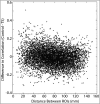Elucidating the nature and mechanism of tic improvement in tourette syndrome: a pilot study
- PMID: 24757584
- PMCID: PMC3983677
- DOI: 10.7916/D8TH8JQQ
Elucidating the nature and mechanism of tic improvement in tourette syndrome: a pilot study
Abstract
Background: For unclear reasons, many Tourette syndrome (TS) children report near-complete tic remission by young adulthood. Immature maturation of brain networks, observed with resting-state functional MRI (rs-fc-MRI) in adolescents and adults with TS, might evolve to a mature pattern in adults who experience tic improvement or remission. We explored the feasibility of testing this hypothesis in our population of young adult TS males, each with prior clinical assessments completed during childhood as part of a separate TS Association Genetics Consortium study.
Methods: A total of 10 TS males (off tic suppressing drugs for at least 6 months) aged 19-32 years, mean follow-up interval 7.5 (2 to 13) years, and 11 neurologically normal controls were enrolled and underwent 3-Tesla structural and rs-fc-MRI sequences.
Results: The mean change in Yale Global Tic Severity Scale (YGTSS) was -31.5% (total) and -26.6% (YGTSS motor+vocal). Two subjects reported resolution of tic-related disability, with drops from mean 45 to 16.5 (YGTSS-total) and 25 to 11.5 (YGTSS motor+vocal.). Rs-fc-MRI revealed significantly increased connectivity between the ipsilateral anterior and mid cingulate cortex and striatum, increased connectivity between local connections, and decreased connectivity between more distant connections; representing an immature connectivity pattern.
Discussion: Similar to previous reports, we found immature patterns of functional connectivity in adult TS subjects. Despite a lack of complete tic remission, two subjects exhibited dramatic drops in tic severity that correlated with tic-related disability improvement. More work is needed to elucidate the mechanism of such dramatic improvement in TS.
Keywords: ADHD; MRI; OCD; Tourette syndrome; tic.
Conflict of interest statement
Figures




Similar articles
-
Sex Differences in People with Tourette Syndrome and Persistent Motor or Vocal Tic Disorder in the Tourette Association of America International Consortium for Genetics Database.medRxiv [Preprint]. 2024 Jan 9:2024.01.07.24300816. doi: 10.1101/2024.01.07.24300816. medRxiv. 2024. PMID: 38260551 Free PMC article. Preprint.
-
Functional connectivity of the precuneus and posterior cingulate cortex moderates the relationship between tic symptoms and premonitory urge in tourette syndrome.Eur Child Adolesc Psychiatry. 2025 Mar 10. doi: 10.1007/s00787-025-02685-x. Online ahead of print. Eur Child Adolesc Psychiatry. 2025. PMID: 40063278
-
Tourette syndrome in a longitudinal perspective. Clinical course of tics and comorbidities, coexisting psychopathologies, phenotypes and predictors.Dan Med J. 2018 Apr;65(4):B5465. Dan Med J. 2018. PMID: 29619935 Review.
-
Determining Clinically Meaningful Improvement in Children and Adolescents with Tourette Syndrome Receiving Pharmacotherapy.J Child Adolesc Psychopharmacol. 2025 May 28. doi: 10.1089/cap.2025.0036. Online ahead of print. J Child Adolesc Psychopharmacol. 2025. PMID: 40272969
-
Cingulate role in Tourette syndrome.Handb Clin Neurol. 2019;166:165-221. doi: 10.1016/B978-0-444-64196-0.00011-X. Handb Clin Neurol. 2019. PMID: 31731911 Review.
Cited by
-
Association of Affected Neurocircuitry With Deficit of Response Inhibition and Delayed Gratification in Attention Deficit Hyperactivity Disorder: A Narrative Review.Front Hum Neurosci. 2018 Dec 18;12:506. doi: 10.3389/fnhum.2018.00506. eCollection 2018. Front Hum Neurosci. 2018. PMID: 30618685 Free PMC article. Review.
-
Maternal autoimmune diseases and the risk of tics and Tourette's disorder in offspring: insights from Taiwan's real-world data.Front Pediatr. 2025 Mar 4;13:1440366. doi: 10.3389/fped.2025.1440366. eCollection 2025. Front Pediatr. 2025. PMID: 40103604 Free PMC article.
-
Putting the Pieces Together in Gilles de la Tourette Syndrome: Exploring the Link Between Clinical Observations and the Biological Basis of Dysfunction.Brain Topogr. 2017 Jan;30(1):3-29. doi: 10.1007/s10548-016-0525-z. Epub 2016 Oct 25. Brain Topogr. 2017. PMID: 27783238 Free PMC article. Review.
-
Neuroimaging in Tourette Syndrome: Research Highlights From 2014-2015.Curr Dev Disord Rep. 2015 Dec;2(4):300-308. doi: 10.1007/s40474-015-0062-6. Epub 2015 Aug 19. Curr Dev Disord Rep. 2015. PMID: 26543796 Free PMC article.
-
Altered brain connectivity in hyperkinetic movement disorders: A review of resting-state fMRI.Neuroimage Clin. 2023;37:103302. doi: 10.1016/j.nicl.2022.103302. Epub 2022 Dec 24. Neuroimage Clin. 2023. PMID: 36669351 Free PMC article.
References
-
- American Psychiatric Association . Washington, DC: 2000. Diagnostic and Statistical Manual of Mental Disorders DSM-IV-TR (Text Revision)
Grants and funding
LinkOut - more resources
Full Text Sources

